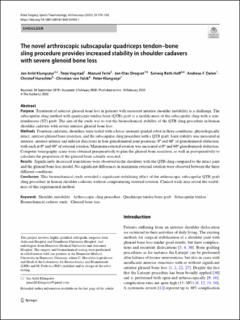| dc.contributor.author | Klungsøyr, Jan Arild | |
| dc.contributor.author | Vagstad, Terje | |
| dc.contributor.author | Ferle, Manuel | |
| dc.contributor.author | Drogset, Jon Olav | |
| dc.contributor.author | Hoff, Solveig Roth | |
| dc.contributor.author | Dalen, Andreas F. | |
| dc.contributor.author | Hurschler, Christof | |
| dc.contributor.author | von, Falck | |
| dc.contributor.author | Klungsøyr, Peter J. | |
| dc.date.accessioned | 2021-04-26T12:00:21Z | |
| dc.date.available | 2021-04-26T12:00:21Z | |
| dc.date.created | 2020-10-22T11:43:01Z | |
| dc.date.issued | 2020 | |
| dc.identifier.citation | Knee Surgery, Sports Traumatology, Arthroscopy. 2020, 29 (1), 170-180. | en_US |
| dc.identifier.issn | 0942-2056 | |
| dc.identifier.uri | https://hdl.handle.net/11250/2739608 | |
| dc.description.abstract | Purpose
Treatment of anterior glenoid bone loss in patients with recurrent anterior shoulder instability is a challenge. The subscapular sling method with quadriceps tendon bone (QTB) graft is a modification of the subscapular sling with a semitendinosus (ST) graft. The aim of the study was to test the biomechanical stability of the QTB sling procedure in human shoulder cadavers with severe anterior glenoid bone loss.
Methods
Fourteen cadaveric shoulders were tested with a force–moment-guided robot in three conditions: physiologically intact, anterior glenoid bone resection, and the subscapular sling procedure with a QTB graft. Joint stability was measured in anterior, anterior inferior and inferior directions in four glenohumeral joint positions: 0° and 60° of glenohumeral abduction, with each at 0° and 60° of external rotation. Maximum external rotation was measured at 0° and 60° glenohumeral abduction. Computer tomography scans were obtained preoperatively to plan the glenoid bone resection, as well as postoperatively to calculate the proportion of the glenoid bone actually resected.
Results
Significantly decreased translations were observed in the shoulders with the QTB sling compared to the intact joint and the glenoid bone loss model. No significant differences in maximum external rotation were observed between the three different conditions.
Conclusion
This biomechanical study revealed a significant stabilizing effect of the arthroscopic subscapular QTB graft sling procedure in human shoulder cadavers without compromising external rotation. Clinical trials may reveal the usefulness of this experimental method. | en_US |
| dc.language.iso | eng | en_US |
| dc.publisher | Springer | en_US |
| dc.relation.uri | https://link.springer.com/article/10.1007/s00167-020-05900-1 | |
| dc.rights | Navngivelse 4.0 Internasjonal | * |
| dc.rights.uri | http://creativecommons.org/licenses/by/4.0/deed.no | * |
| dc.title | The novel arthroscopic subscapular quadriceps tendon–bone sling procedure provides increased stability in shoulder cadavers with severe glenoid bone loss | en_US |
| dc.type | Peer reviewed | en_US |
| dc.type | Journal article | en_US |
| dc.description.version | publishedVersion | en_US |
| dc.source.pagenumber | 170-180 | en_US |
| dc.source.volume | 29 | en_US |
| dc.source.journal | Knee Surgery, Sports Traumatology, Arthroscopy | en_US |
| dc.source.issue | 1 | en_US |
| dc.identifier.doi | 10.1007/s00167-020-05900-1 | |
| dc.identifier.cristin | 1841431 | |
| cristin.ispublished | true | |
| cristin.fulltext | original | |
| cristin.qualitycode | 1 | |

